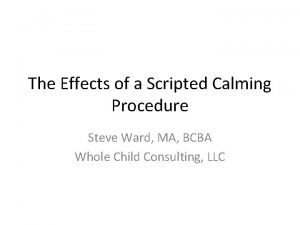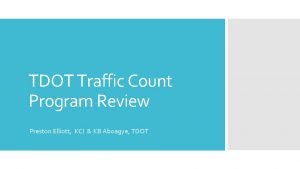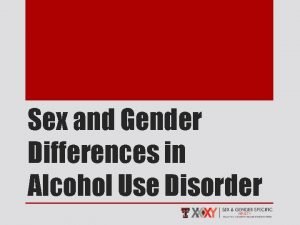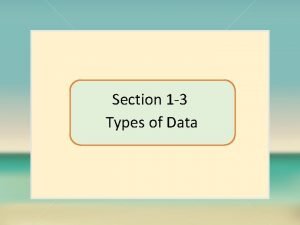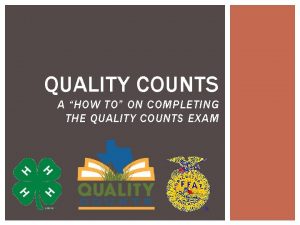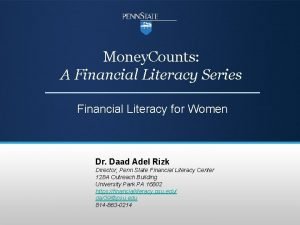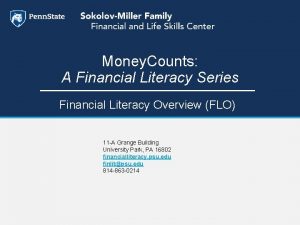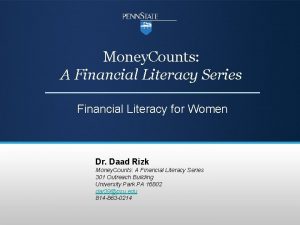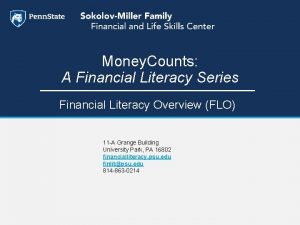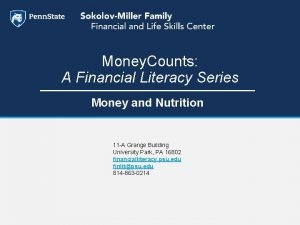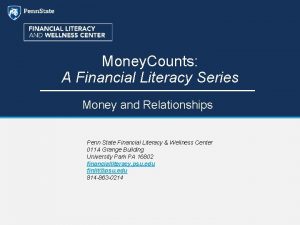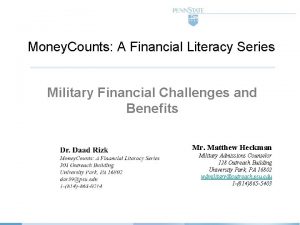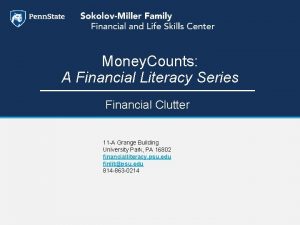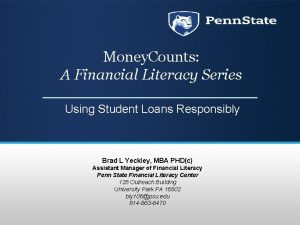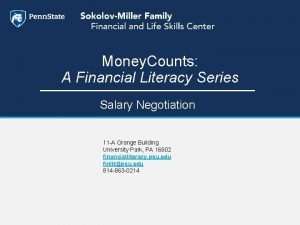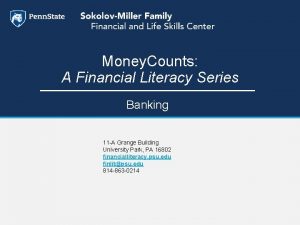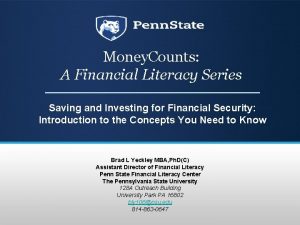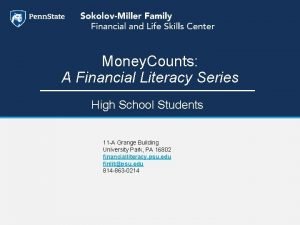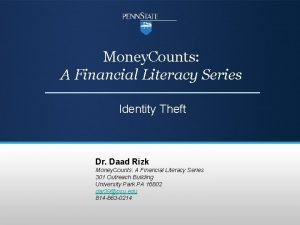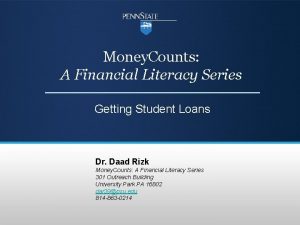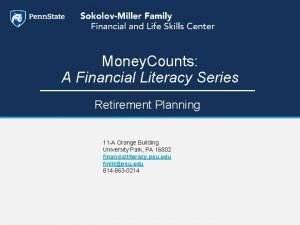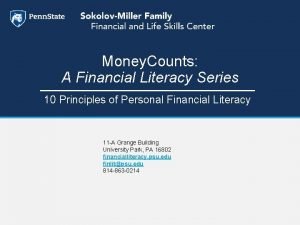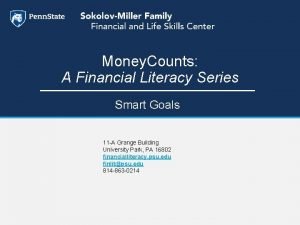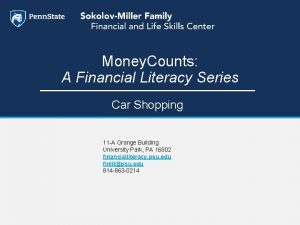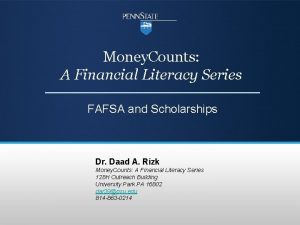Money Counts A Financial Literacy Series Financial Literacy























- Slides: 23

Money. Counts: A Financial Literacy Series Financial Literacy Overview (FLO) 11 -A Grange Building University Park, PA 16802 financialliteracy. psu. edu finlit@psu. edu 814 -863 -0214

• The Pennsylvania State University is committed to provide students with the resources needed to make informed decisions regarding their money management Description • But what is Financial Literacy? What are the main principles that a student should explore? And what is the purpose of becoming financially literate? • Financial Literacy is not just about managing your money, it dives deep to help you question your attitudes and values toward money and guides you to reach a life full of financial security and freedom

• Identify the core competencies for financial literacy Learning Outcomes • Explore the knowledge using the KAB concept o Knowledge, Action, Behavior • List practical strategies to becoming financially literate • Discuss financial security and freedom goals

Why do we need financial literacy? For your future financial freedom!

KAB Principle Knowledge Action Behavior Financial Literacy

Core Competencies

Earning – Core Competency #1 Knowledge Action/Behavior • Gross versus net paycheck • • Understand your paycheck Verify and adjust your exemptions and deductions on your W 4 (withholding) • Benefits and taxes • Learn about potential benefits and taxes • Education is important • Invest in your future, plan for your career through education – search the market

Saving & Investing – Core Competency #2 Knowledge Action/Behavior • Saved money grows • Start saving early, pay yourself first • Banking – saving and checking accounts • Comparison shopping for a financial institution – reconcile your accounts • Long-term financial planning • Plan for retirement, child education, renting versus owning a home • Eliminate or reduce waste • Replace with saving

Spending – Core Competency #3 Knowledge Action/Behavior • Difference between needs and wants • Develop a spending plan • Develop a quantitative awareness of your spending habits • • Track spending habits Live within your means • Get the most/best value for your money • Understand the social and environmental impact of your spending decisions

Borrowing – Core Competency #4 Knowledge Action/Behavior • Distinguish net income from loans • • Cost of borrowing: Penalty, interest, late fee, surcharges (PILS) • • Borrow only what you need (rather than what you want) Avoid high cost loans, penalties, late fees, and surcharges • Minimize interest payments • Get your free annual report, check your financial grade, review and correct if necessary • Shop for low interest cards, use only in emergencies, avoid paying PILS Amortization schedules • Credit Score – FICO: Equifax, Experian, Trans. Union • Credit cards

Protecting – Core Competency #5 Knowledge Action/Behavior • Risk management and insurance coverage • Shop for insurance, review and update insurance, build up an emergency fund • Identity theft • Watch for your social security number and cards, your date of birth, and your banking information • Fraud and scam • It is too good to be true, it most certainly is

Budgeting

Increase income

Decrease Spending

10. 00% 1. Saving 10. 00% 2. Housing 30. 00% 10. 00% 3. Utilities 5. 00% 4. Food 20. 00% 5. 00% 30. 00% 5. Transportation 10. 00% 6. Entertainment 5. 00% 7. Debt 10. 00% 20. 00% 8. Other 10. 00%

• Find an app to help you create and stick to a budget Quick tips for students • Use bank accounts that offer free saving, checking, and ATM services & watch for overdrawing funds • Avoid impulse buys • Find free social activities on campus • Use the free CATA Bus service • Pack healthy snacks • Budget your meal plan • Establish an emergency fund • Pay credit card balance in full and on time

Budgeting your meal plan https: //foodservices. psu. edu/campus-meal-plan

Scholarships • Scholarships are a form of gift aid that does not need to be re-paid. The Penn State scholarship awarding process is very de-centralized, with each College having its own awarding process. https: //studentaid. psu. edu/types-ofaid/scholarships

Student Loan Balance Know how much you owe!!! • By July 2020, the Penn State Office of Student Aid will be sending notification to each student to let them know their student loan aggregate balance to date. Make sure you are aware of how much you owe. Please check your loan debt balance each semester. https: //nslds. ed. gov/nslds_SA/

Health Insurance Requirement s • Penn State requires all international students to have health insurance and will be implementing a University -wide health insurance requirement for all students during the 2019 -2020 academic year. https: //studentaffairs. psu. edu/healthwellness/health-insurance

Student Financial Responsibility Agreement • Penn State students have to sign a financial responsibility agreement prior to enrolling in classes to certify their obligation to pay all outstanding balance, together with all fees and costs, due Penn State • https: //tutorials. lionpath. psu. edu/p ublic/Docs/FRA. pdf

Elements of financial well-being Present Future Security Control over day-to-day, month-to-month finances Capacity to absorb financial shock Freedom of choice Financial freedom to make choices to enjoy life On track to meet financial goals

Money. Counts: A Financial Literacy Series Comments and questions 11 A Grange Building University Park, PA 16802 financialliteracy. psu. edu finlit@psu. edu 814 -863 -0214
 Money money money team
Money money money team Site:slidetodoc.com
Site:slidetodoc.com Money smart money match
Money smart money match Money on money multiple
Money on money multiple Satire in the great gatsby
Satire in the great gatsby Old money vs new money
Old money vs new money Information and media literacy similarities
Information and media literacy similarities Media and information literacy memes
Media and information literacy memes Similarities between people in media and people as media
Similarities between people in media and people as media Cyber literacy for the digital age
Cyber literacy for the digital age Maclaurin series vs taylor series
Maclaurin series vs taylor series Heisenberg 1925 paper
Heisenberg 1925 paper Taylor series of composite function
Taylor series of composite function Maclaurin polynomial
Maclaurin polynomial Ibm p series
Ibm p series Series-shunt feedback amplifier examples
Series-shunt feedback amplifier examples Series aiding and series opposing
Series aiding and series opposing Sum of infinite series formula
Sum of infinite series formula Steve ward calm counts
Steve ward calm counts Tdot traffic counts
Tdot traffic counts What counts as one drink
What counts as one drink It consists of numbers representing counts or measurements.
It consists of numbers representing counts or measurements. Quality counts background checks
Quality counts background checks Cry unit
Cry unit


















